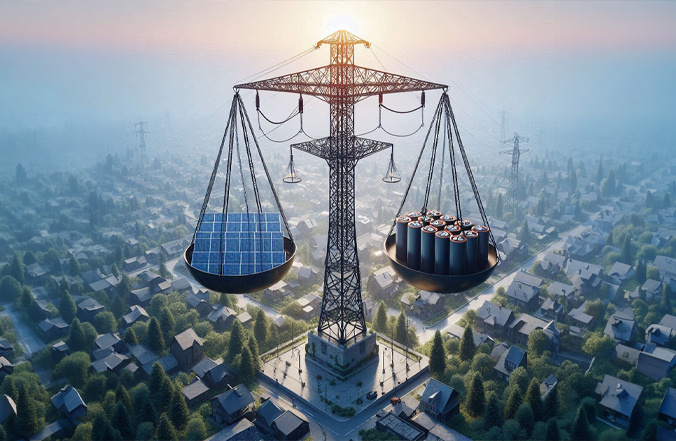Nor-Cal Controls dives into the world of solar and battery energy storage systems (BESS) at CAISO-connected sites, specifically focusing on how a Main Plant Controller (MPC) keeps everything running smoothly.
What is a Main Plant Controller (MPC)?
Think of the MPC as the brain of your solar and battery operation. It's a control system with two main jobs:
- Managing Real and Reactive Power: It receives MW setpoints (instructions) from CAISO's Automated Dispatching Service (ADS) and Automatic Generation Control (AGC) to control how much real power (energy) your solar panels generate and how much your battery system stores or releases. This ensures your site contributes efficiently to the grid's needs.
- Maintaining Voltage Stability: The MPC also keeps the voltage at your site in check through a function called Automatic Voltage Regulation (AVR). It does this by adjusting the reactive power output and adsorption of your solar and battery system.
How the MPC Works with Solar and Battery Systems
The MPC communicates with two other controllers:
- Solar Power Plant Controller (PPC): This controller acts as the middleman between the MPC and your solar panels. It receives instructions from the MPC and translates them into commands for the solar inverters, ultimately controlling how much energy your solar panels generate. The PPC also sends real-time data on power generation back to the MPC for overall system monitoring.
- Battery Energy Storage System (BESS) EMS Controller: This controller acts as the brain of your battery system. It receives setpoints from the MPC regarding charging and discharging and translates them into commands for the battery inverters. The BESS EMS controller also monitors the battery's health and performance, sending this data back to the MPC for centralized control.
Key Control Features of the MPC
- Prioritization During Overgeneration: If your solar and battery system produces more power than your transformers can handle, the MPC prioritizes solar generation by default. However, the operator can switch this priority to the battery system if needed.
- Loss Compensation: The MPC considers energy losses within your system to ensure accurate control and revenue metering.
- Balancing Battery Usage: When discharging the battery, the MPC prioritizes units with higher State of Charge (SOC) to maintain balanced usage across your battery system. The same applies when charging the battery, prioritizing units with lower SOC.
- BESS Charging Modes and ITC Compliance: The MPC offers different charging modes for your battery system, including a default mode called "PV Only Charge Mode." This mode ensures compliance with Investment Tax Credits (ITC) by limiting battery charging to the amount of solar power your site is generating, minus a buffer amount set by the operator. The MPC constantly monitors these factors:
- Total PV Power Production: Measured using compensated values to account for energy losses.
- Operator-Adjustable Buffer: This buffer ensures the battery doesn't over-charge based on solar generation. The MPC takes action if the battery charging attempts to exceed these limits:
- Warnings and Adjustments: If the buffer is exceeded for a set time, the MPC reduces the charging rate or stops charging the battery altogether.
- Breaker Trips: In extreme cases, if the buffer violation persists, the MPC might trip breakers to isolate the battery system, preventing potential damage.
Advanced Features: Integration with SCADA and HMI
The MPC can seamlessly integrate with Supervisory Control and Data Acquisition (SCADA) systems and Human-Machine Interfaces (HMI). SCADA systems provide a centralized platform for monitoring and controlling various aspects of your solar and battery system. The MPC feeds real-time data on power generation, battery health, and overall system performance into the SCADA system. This data empowers operators to gain a comprehensive understanding of the system's behavior and make informed decisions. Additionally, the HMI acts as a user-friendly interface for operators to interact with the MPC. They can monitor key system parameters, adjust settings, and even override certain control functions in specific situations.
Communication Protocols: The Language of the MPC
For the MPC to effectively communicate with other controllers and systems, it relies on standardized communication protocols. These protocols define the format and structure of data exchange, ensuring seamless information flow. Common communication protocols used by MPCs include:
- Modbus: A widely adopted protocol for industrial automation applications. Modbus enables the MPC to exchange data with various devices within the solar and battery system. Modbus is strictly poll based and lacks quality, timestamp and event attributes.
- DNP3: Another prevalent protocol in the energy sector, DNP3 offers robust communication capabilities for critical infrastructure like solar and battery systems. DNP3 is event based, provides timestamp and quality attributes.
- IEC 61850: This protocol is specifically designed for substation automation and provides a reliable and secure communication framework for the MPC to interact with other intelligent devices in the system.
The Benefits of an MPC
Implementing an MPC in your solar and battery system offers a multitude of advantages:
- Optimized Performance: The MPC ensures your solar and battery system operate at peak efficiency. It constantly monitors and adjusts power output based on real-time grid requirements and optimizes setpoints for the solar inverters and battery management systems. This ensures you maximize your energy production and grid contribution while minimizing energy waste.
- Enhanced Reliability: By maintaining voltage stability and prioritizing safe operation, the MPC safeguards your solar and battery system from potential damage caused by voltage fluctuations or overcharging. The MPC's Automatic Voltage Regulation (AVR) function continuously monitors voltage levels and makes adjustments as needed, preventing voltage sags or surges that could harm your equipment. Additionally, features like overgeneration prevention and BESS charging mode limitations ensure the system operates within safe boundaries.
- Compliance with Regulations: The MPC ensures your system adheres to relevant grid interconnection standards and ITC regulations. Its features like PV Only Charge Mode and loss compensation guarantee compliance, avoiding potential penalties or grid disconnection. The MPC can also be configured to integrate with external control systems from grid operators, ensuring seamless communication and adherence to dispatch instructions.
- Simplified Operations: The MPC automates many control functions, reducing the operational burden on your team. Operators can focus on monitoring system performance and making strategic decisions, leveraging the MPC's capabilities for efficient system management. The MPC's automated control loops and setpoint adjustments minimize the need for manual intervention, freeing up operator time for higher-level tasks.
- Scalability and Future-Proofing: As your solar and battery system grows, the MPC can adapt and integrate seamlessly with additional components. This scalability ensures your control system can evolve alongside your renewable energy ambitions. Whether you're expanding your solar array capacity or adding additional battery storage units, the MPC can readily accommodate these changes, ensuring continued efficient operation of your growing renewable energy system.
The Main Plant Controller (MPC) silently orchestrates a complex symphony of power generation, storage, and grid interaction, ensuring everything runs smoothly and efficiently. By understanding the MPC's functionalities and its importance in optimizing performance, maintaining reliability, and adhering to regulations, you can harness the full potential of your solar and battery system and contribute to a cleaner, more sustainable future.
Looking for More Information?
If you're interested in learning more about how a Main Plant Controller can benefit your solar and battery systems, contact Nor-Cal today. Our team of experts can answer your questions and guide you towards the optimal solution for your renewable energy needs.





